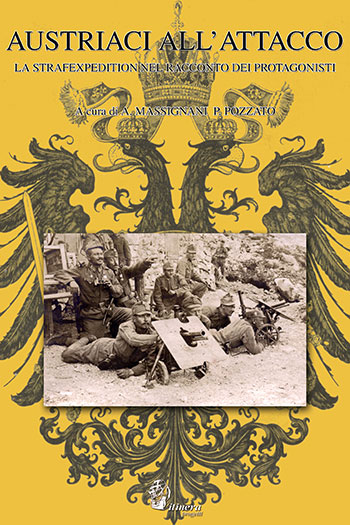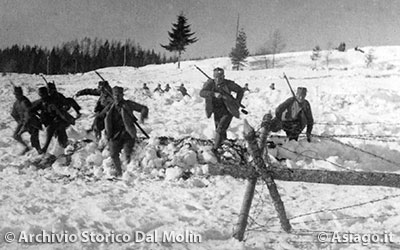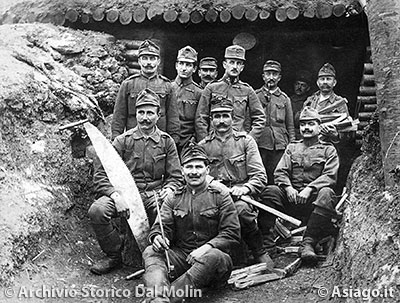
The AUSTRIAN To book attack of Alessandro Massignani and Paul Pozzato with photos from the Archivio Storico Dal Molin
-
Title The Austrians to attack
-
Subtitle The Strafexpedition in tale of the Protagonists
-
360 Pages
-
Cover price € 21,00
-
Publishing House Itinera Projects
-
Author (s) Paul Pozzato (Author), Alessandro Massignani (Author)
-
Publication Date 2006
-
ISBN 10 8888542213
-
ISBN 13 978-8888542218
- Buy direct online
Buy Now
If there is a significant event that characterizes the great war of the Vicenza and its historical memory, an event that made him "feel" the war to vicentini, was undoubtedly theAustro-Hungarian offensive in may 1916, better known as Strafexpedition.
The journalist Giuseppe Damte painted in those days effectively the beginning of nightmare:
«A left ROAR shook the mountains in the afternoon of 14 may, became more frequent and more vehement overnight, infocando the tops, broke in hurricane on the morning of 15. From Rovereto in Borgo, from the Adige to the Brenta, but especially between the Astico and Posina had triggered the battle. The Crown of Austria Archduke had risen on High di Folgaria and gave the signal to attack ' the conquest of Vicenza ...».
❧❧❧❧
Pur away these memories were passed down in oral tradition that echoes dark and scary moments when the night lightning and dull rumbling of Cannon on top of the mountains surrounding threatening seemed to lead to the sudden evacuation of the population towards distant and unknown lands, bringing with him a few things put together in a very short time allowed by military authorities.
Theoffensive of the spring of 1916 in South Tyrolfor Italians, "the Austrian offensive in Trentino", he gained the popular nickname Strafexpedition both in Austrian military both among Italians who were aware, thanks to the efficiency of thefirst army's information Office, because of its nature psychologically well defined for a showdown with the former ally of the Kingdom of Italy.
❧❧❧❧
Aquite relevant to the province of Vicenza, the strategic importance of the Strafexpedition under limited war General appears, at least judging from the texts of General history of the first World War: for example speaks with little knowledge of the facts Lloyd George in his memoirs and in a way misleading Norman Stone in his study of the war in the East.
 However if we look at the consequences we can see how it has been for the conduct of Austria-Hungary's war a moment of enormous importance, because the final result of the offensive was not only its failure, but because of the contemporary disaster on the Russian front caused by the General offensive Brussilov Aleksieevich Aleksiei and the subsequent request of the German competition, the end of the military and political autonomy ofAustria Hungary against the more powerful German ally.
However if we look at the consequences we can see how it has been for the conduct of Austria-Hungary's war a moment of enormous importance, because the final result of the offensive was not only its failure, but because of the contemporary disaster on the Russian front caused by the General offensive Brussilov Aleksieevich Aleksiei and the subsequent request of the German competition, the end of the military and political autonomy ofAustria Hungary against the more powerful German ally.
❧❧❧❧
Per Italians it was instead the first defensive operation, in which the efficiency ofCadorna's Army was put to the test: never before had been trampled the soil patrio in an offensive war that had seen Italian troops advance into territories of the monarchy. The meaning of this less flashy but his boldness in relation to the times, which gave rise to a great battle in the mountains, up over 2000 m, involving two austro-Hungarian armies when the season was still unfavorable.
Recall that the war in the mountains developed in the first world war, mainly on the Balkan front and Italian and which until 1904 had not been provided byAustria-Hungary military operations in Trentino, nor for that matter by the Italian side.
❧❧❧❧
 Fino at the beginning of the century, in fact, most regulations stipulated that mountain areas could be splash zone to the bottom of the Valley or at best secondary zones of small operations departments.
Fino at the beginning of the century, in fact, most regulations stipulated that mountain areas could be splash zone to the bottom of the Valley or at best secondary zones of small operations departments.
To operate as an alternative to the traditional invasion routes of needed specially trained and equipped troops such as the Alps or the Kaiserjäger and the Landschützen, on the Austrian side, according to the concepts of mountain warfare that some pioneers supported. Moreover, the "Highlands" appeared as a soil suitable to operate with the infantry, almost as much as an elevated plain, but this would have been an illusion than the logistical difficulties that the operation involved.
All rights reserved.